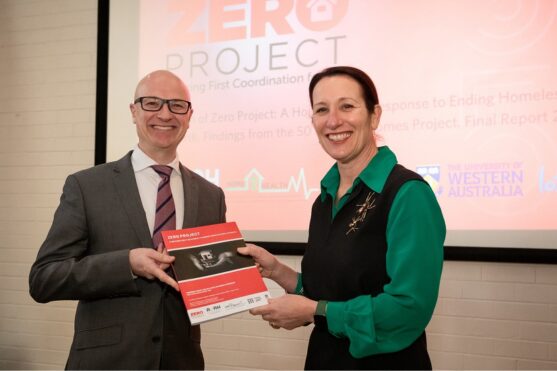50 Lives 50 Homes: the modest grant that led to hundreds leaving homelessness

This story was first published in the hardcopy edition of Inspiring Stories of Giving volume 1 in October 2023.
The 50 Lives 50 Homes project was conceived to help alleviate homelessness. Its name suggested its initial ambition, but support grew to include a collective of 30 community service agencies and the Western Australian Government. It wasn’t long before it outstripped its aim of helping 50 people into homes. It reached 427 last year and is still growing.
The project came to life with the vision and generosity of the Sisters of St John of God, a religious congregation in Perth who since 1895 have been helping marginalised and vulnerable groups, first in Western Australia and then across the country.
Ruah Community Services contacted the Sisters to support a new approach to solving homelessness. When the Sisters offered to assist by funding a modest grant over three years, 50 Lives 50 Homes was born. A few years later, the successful outcomes led to millions of dollars of state government funding investment for homelessness services based on the model.
The project was a different model from conventional housing responses, based on an idea conceived initially in the US and Canada. The aim was to provide appropriate housing first, then address other issues that had been impacting on a person’s ability to maintain a tenancy, known as a “Housing First” approach. The model addresses issues such as chronic health, drug and alcohol use and financial debt, which often “deteriorated” tenancies. The research showed that addressing the need for shelter and “wrap-around” supports meant that tenants can focus on recovery and wellness.
Ruah, with the collaborative sector agencies, piloted the program in Perth in 2017 after the successful 500 Lives/500 Homes in Brisbane. The program, led by Ruah for five years and taken over by the Zero Project and the WA Alliance to End Homelessness (WAAEH) in 2022, showed that tenancy retention rates rose from around 40% before the program to 75-80%. It meant the tenants remained connected and support was never far away, including after hours.

Debra Zanella (pictured in the banner image above), CEO of Ruah Community Services, says it’s a model of philanthropy that allows agencies to “test and try” to see what works and what doesn’t. “The Sisters understood the complex nature of how best to achieve impact in this space,” says Debra. “It was, ‘Let us give you the freedom to test and try – even if it doesn’t succeed, we’ll at least have known’. And using that for galvanising greater impact and change rather than an expectation that, ‘We’re only investing in something that is going to have impact’.”
The stories of people that 50 Lives 50 Homes helped demonstrate the impact the project has had. Anthea is an award-winning artist (having won many community arts prizes across WA and NAIDOC Week Awards), who now volunteers a lot of her time in community. She’s given back to Kambarang Place women’s refuge teaching art classes to the Aboriginal and Torres Strait Islander women escaping domestic violence or other life crises.
Anthea had been dealing with housing issues then also faced a health crisis. “I hit rock bottom when I got a melanoma on my foot and had to undergo a below-the-knee amputation,” she says. “It was during this dark moment of my life that I came into contact with the 50 Lives 50 Homes program.”

The 50 Lives 50 Homes team helped Anthea secure long-term housing and supported her to access medical treatment. It was initially a challenging adjustment. “When I first moved into my home, I felt like an alien. I didn’t know how to live in a house. But now I can feel safe. I have four walls around me and I can be warm in winter and cook myself a meal.
“It’s very hard being homeless – there are struggles and it’s very depressing. Ruah has programs to help support people so they don’t feel so much alone.”
That impact is clear to Western Australian Minister for Housing and Homelessness John Carey. “The 50 Lives 50 Homes project was a successful pilot program and formed the basis of the Cook Labor Government’s Housing First Homelessness Initiative (HFHI), which is transforming the lives of vulnerable Western Australians,” Mr Carey says.
“The HFHI is a State Government-led initiative providing accommodation and wrap-around support to people sleeping rough or experiencing homelessness in the Perth Metropolitan Area, Rockingham/Mandurah, Bunbury and Geraldton.”
The WA Government is investing $2.6 billion in housing and homelessness measures, including the delivery of 4,000 social homes and maintenance and refurbishments to many thousands more. Minister Carey says: “Following the success of the pilot 50 Lives 50 Homes project, our Government significantly scaled up the HFHI with a $34.5 million investment across a number of communities – including the Perth metropolitan area, Geraldton and Bunbury. The HFHI is currently supporting nearly 170 people across Western Australia.”
The “Housing First” approach has become a mainstream response to homelessness support. “We know we will never eradicate homelessness altogether, but it’s certainly a solvable problem,” says Debra. “It should be rare, and it should be resolved immediately.”
From the support of the Sisters, an initial financial contribution and a team that grew, 50 Lives 50 Homes has had significant impact. It is an inspiring example of advocacy funding leading to major investment. “The Sisters are really delighted,” says Mark Murphy, Regional General Manager at SSJG Ministries of the project’s success. “It’s made a great difference to the people who’ve been helped by the 50 Lives 50 Homes project. It turned out to be far more than 50 people. The incorporation of the ‘housing first’ model into the State Government strategy is a positive for strengthening the response to homelessness in WA.”